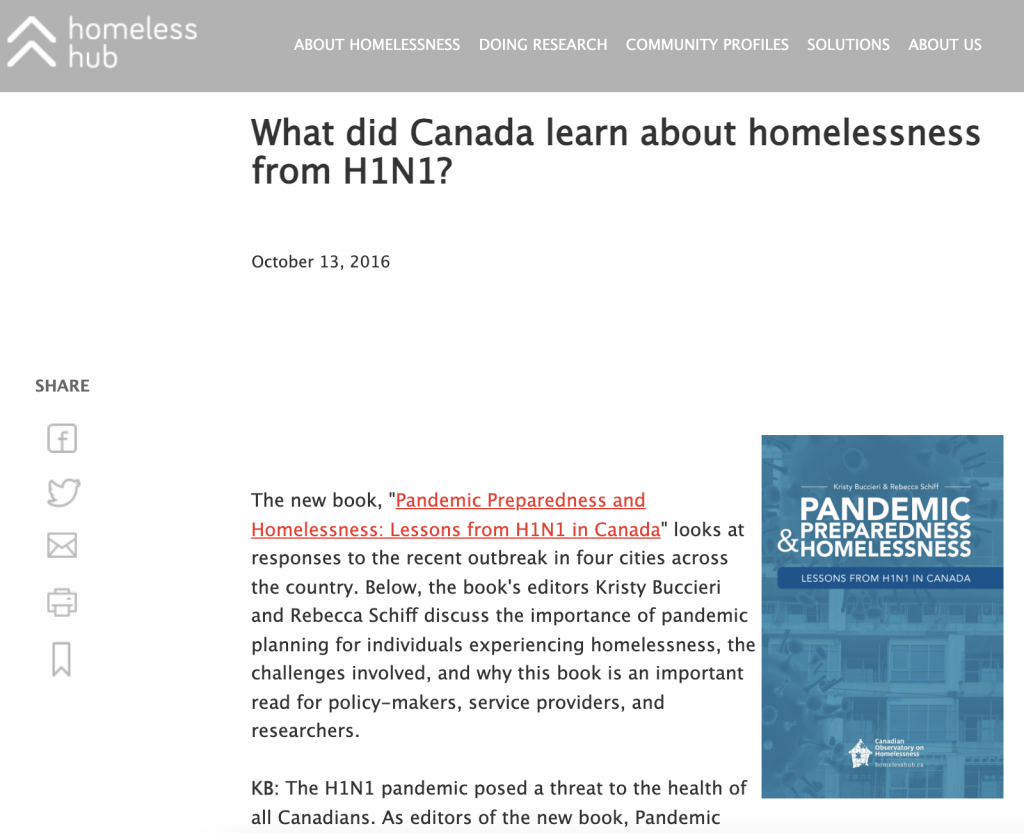1. Why are people who experience homelessness at higher risk during a pandemic?
The chances are pretty good that you have heard about the COVID-19 pandemic, so we will not devote a considerable amount of space to explaining its particulars. It should suffice to contextualize it as a worldwide outbreak that emerged in 2019 and continued at least up until the time this book was being written in the late Fall of 2021. Whether you are reading this while the effects of the COVID-19 pandemic are still being felt around the world, or whether you are fortunate to be reading this in a post COVID-19 era, we encourage you to take a moment here to think about its impact on people experiencing homelessness. This reflection may be as brief or as long as you wish.
How to complete this activity and save your work: Type your response to the question in the box below. When you are done answering the question navigate to the ‘Export’ page to download and save your response. If you prefer to work in a Word document offline you can skip right to the Export section and download a Word document with this question there.
 Photo by Alex Azabache on Unsplash Photo by Alex Azabache on Unsplash |
When you think of COVID-19, what comes to mind? Perhaps you recall the many messages we all commonly heard during this period:
-
-
- Stay at home
- Keep your distance from others
- Wash your hands
- Wear a mask and change it frequently
- Get vaccinated as soon as you are eligible
-
All good advice, if you have a home, the ability to stay away from others, hygiene facilities in which to wash, access to multiple masks or laundry facilities, and have been given priority vaccination status. Based on what you have learned so far in this book, how much of this advice do you think applies to people experiencing homelessness?
The importance of having safe and secure housing as a determinant of health became abundantly clear during the COVID-19 lockdowns that were implemented across Canada, and more broadly around the world. You may recall hearing that people experiencing homelessness are at increased risk during a pandemic. Indeed, this risk is two-fold. They are medically at risk because of a high rate of underlying chronic health conditions, and socially at risk because of a lack of housing and control over their living environments which makes it particularly challenging to follow public health directives like staying at home and keeping one’s distance (Perri, Dosani, & Hwang, 2020). In the video that follows Dr. Rebecca Schiff discusses these medical and social conditions in more detail.
 When the videos in this ebook are almost done playing, the message “Stop the video now” will appear in the top left corner. This is a reminder for those who have turned on the Autoplay setting to manually pause the video when the speakers are done to avoid having it autoplay through to the next video. This message will appear in all researcher videos throughout the ebook.
When the videos in this ebook are almost done playing, the message “Stop the video now” will appear in the top left corner. This is a reminder for those who have turned on the Autoplay setting to manually pause the video when the speakers are done to avoid having it autoplay through to the next video. This message will appear in all researcher videos throughout the ebook.
Note: Viewers may still need to use their discretion in stopping other YouTube content such as ads.
Dr. Rebecca Schiff: Why are people who experience homelessness at higher risk during a pandemic?
In this video, Dr. Rebecca Schiff argues that there are several reasons people who experience homelessness are at higher risk during a pandemic. Notably, she states the COVID-19 pandemic demonstrated that having a home or private space is the safest place to avoid infection, but those who experience homelessness do not have this same access. Additionally, shelters are congregate settings where people live and work in close quarters, increasing the risk of transmission. Lastly, people who experience homelessness are often in poor health and may lack a strong immune system to fight off infection. This video is 1:54 in length and has closed captions available in English.
Key Takeaways – Dr. Rebecca Schiff: Why are people who experience homelessness at higher risk during a pandemic?
- The COVID-19 pandemic has demonstrated that having a house, and staying at home, is the safest place to be to avoid infection.
- A person who is homeless does not have a house or isolated place to go to avoid high-risk, high-transmission areas.
- Shelters are congregate settings where people work and live in close quarters, increasing the risk of transmission.
- People who experience homelessness are often in poor health and might not have a strong immune system to fight off infection.
It has become commonplace to use the terms, “COVID-19” and “the pandemic” interchangeably, but it is critical to recognize that there have been pandemic outbreaks in previous years, such as SARS in 2003 and H1N1 in 2009-2010. During the H1N1 pandemic, a team of researchers from across Canada conducted a multi-site study to evaluate the readiness of homelessness sectors to deal with infectious outbreaks. This study took place in Victoria (Pauly, Perkins, & Cross, 2016), Toronto (Buccieri, 2016; Gaetz & Buccieri, 2016), Calgary (Waegemakers Schiff & Lane, 2016), and Regina (Schiff, 2016b).
Writing about this study, Gaetz and Buccieri (2016) indicated that we need to consider the ways the infrastructure we have built to respond to homelessness – such as crowded shelters, congregate sleeping and eating spaces, and inadequate onsite hygiene facilities – organize the lives of people within these spaces in a way that increases their risk while simultaneously reducing their sense of control. The findings of this study were published in an open access e-book entitled “Pandemic Preparedness and Homelessness: Lessons from H1N1 in Canada“, which is freely available on the Homeless Hub website (Buccieri & Schiff, 2016).
This book was released in October 2016. As part of its launch, the co-editors Dr. Rebecca Schiff and Dr. Kristy Buccieri wrote a conversational blog post discussing the importance of pandemic planning for people experiencing homelessness and the impact they hoped the book would have for pandemic planning and preparedness in the future. We invite you to read the blog post now while keeping in mind that this was written many years before the COVID-19 outbreak.
Click the image below to open a new window and read the full blog post, “What did Canada learn about homelessness from H1N1?” by Dr. Rebecca Schiff and Dr. Kristy Buccieri.
 |
What do you think?
 Reflecting on the H1N1 outbreak in Toronto, Gaetz and Buccieri (2016) have written, “A key question to ask is whether we are prepared – or more to the point, is it possible to prepare – to adequately respond to the risks faced by the homeless population in the event of a serious pandemic?” This piece of foreshadowing was written well before the COVID-19 outbreak began. Looking backward, do you think we were adequately prepared to respond to the risks of COVID-19 for people experiencing homelessness? Was it possible to be more prepared?
Reflecting on the H1N1 outbreak in Toronto, Gaetz and Buccieri (2016) have written, “A key question to ask is whether we are prepared – or more to the point, is it possible to prepare – to adequately respond to the risks faced by the homeless population in the event of a serious pandemic?” This piece of foreshadowing was written well before the COVID-19 outbreak began. Looking backward, do you think we were adequately prepared to respond to the risks of COVID-19 for people experiencing homelessness? Was it possible to be more prepared?
Lead co-researchers on the project, Dr. Jeannette Waegemakers Schiff, Dr. Bernie Pauly, and Dr. Rebecca Schiff wrote in the book, “We hope, in the event of future pandemics, the important lessons from H1N1, an outbreak that did not turn out to be as severe as expected, will be taken up by regional and provincial health planners to ensure the health and safety of people who are homeless. There is also a clear need to initiate a public health response to homelessness, even when there is no imminent threat of a pandemic” (Waegemakers Schiff, Pauly, & Schiff, 2016, pg. 180). Here Dr. Jeannette Waegemakers Schiff shares her thoughts on the COVID-19 outbreak and the lessons not learned from H1N1.
Dr. Jeannette Waegemakers Schiff: Why are people who experience homelessness at higher risk during a pandemic?
In this video, Dr. Jeannette Waegemakers Schiff reflects on the increased psychological, moral, and physical harm that people who are unsheltered face during a pandemic. She notes that while people are told to stay home, those without housing are unable to shelter in place and lack the ability to store food and other essential supplies. She argues that people who experience homelessness are at greater risk of not being able to take self-protective measures, such as remaining socially distant in congregate service settings. Additionally, while people who are unsheltered are at increased risk of exposure, they also have fewer protections. For instance, access to disposable masks or laundry facilities for cloth masks is limited in homelessness agencies. Dr. Waegemakers Schiff notes that during COVID-19 many service agencies struggled to meet the needs of their clients. While some were prepared and able to implement social distancing measures, many people still were left sleeping on mats on the floor, next to others. In response, some cities moved unsheltered people who tested positive or showed symptoms of having COVID-19 to hotels to quarantine. While Dr. Waegemakers Schiff notes that the public health need for this was clear, additional considerations should have been made for individuals who had previously been incarcerated and/or who use substances and might find the hotel quarantine protocols overly restrictive. This video is 7:05 in length and has closed captions available in English.
Key Takeaways – Dr. Jeannette Waegemakers Schiff: Why are people who experience homelessness at higher risk during a pandemic?
- People who are without shelter during a pandemic are at the greatest risk of psychological, moral, and physical harm.
- People are told to stay home during a pandemic, but those without housing have nowhere to shelter in place.
- Without housing, people also lack the ability to store food and essential supplies.
- People who are unsheltered, provisionally sheltered, or partially sheltered are at greater risk of not being able to undertake self-protective measures.
- People who experience homelessness tend to have more health problems than people who are sheltered.
- People without housing have very few options for remaining socially distanced, particularly if they rely on social service agencies, which tend to be congregate settings.
- People who experience homelessness during a pandemic are not only more likely to be exposed to infection from being in congregate settings, but they are also less likely to have protections.
- Access to new masks or facilities to launder masks is limited in homelessness agencies.
- Homelessness service agencies have struggled to operate and meet client needs during the COVID-19 pandemic.
- Some shelters, such as one in Calgary, were able to provide increased social distancing but still had people sleeping in close proximity on mats on the floor.
- Some service agencies had planned, and were prepared, for pandemic outbreak within their organization. Those that had not, were more dependent on other agencies for guidance, support, and tangible items like personal protective equipment [PPE].
- Some cities used hotels to quarantine people experiencing homelessness who tested positive or showed signs of having COVID-19. The public health need for this was clear, but there were other considerations that should have been made.
- Many people who experience homelessness have had interactions with the justice system, including having been incarcerated. Being placed in a quarantine hotel, without being able to leave, felt like a similar experience.
- Hotels may not have been set up with harm reduction policies that permit people who smoke or use substances to do so in their unit. Not being allowed to use substances made some people want to leave.
The current way we manage homelessness – by keeping strangers close together in overcrowded settings with limited hygiene facilities – is the complete opposite of what public health officials advise in pandemic outbreaks. While the COVID-19 pandemic impacted society as a whole, homelessness shelters and agencies are often plagued by outbreaks of tuberculosis, influenza, lice, and bed bugs. An investigation of risk factors for Group A Streptococcus outbreak in shelters showed the need for improved wound care, infection prevention and control practices, early screening and detection of skin and soft tissue infections (Dohoo, Stuart, Finkelstein, Bradley, & Gournis, 2020), which is outside the scope of care most shelters are able to provide. In the next video, Dr. Stephen Hwang discusses infection, displacement, and the broad range of factors that put people at particularly high risk when experiencing homelessness during a pandemic.
Dr. Stephen Hwang: Why are people who experience homelessness at higher risk during a pandemic?
In this video, Dr. Stephen Hwang tells the story of a research associate who was surprised at the congregate nature of shelters and drop-in centres during the COVID-19 pandemic. Dr. Hwang notes that the pandemic did not create, but rather unmasked, the conditions that were already present increasing the risk of airborne and droplet born diseases in these settings. He argues that while infection is a concern, there are also a range of additional risks people who experience homelessness face during a pandemic, related to displacement and the lack of access to basic services. Notably, he cites the lack of access to washrooms, higher rates of overdose deaths, increased levels of stress, and impaired mental health as particular risk factors for people experiencing homelessness. Dr. Hwang concludes that for those living in encampments, routine clearances have led not only to displacement but to the disruption of social and support networks as well. This video is 3:11 in length and has closed captions available in English.
Key Takeaways – Dr. Stephen Hwang: Why are people who experience homelessness at higher risk during a pandemic?
- It is apparent in spaces used for people experiencing homelessness, such as shelters and drop-in centres, that putting people together in congregate settings creates a high-risk situation for the spread of COVID-19 and other infectious diseases.
- The pandemic did not create, but rather unmasked, the conditions that were there all along, increasing the risk of airborne or droplet born diseases.
- In addition to infection, people who experience homelessness during a pandemic are also susceptible to higher risks related to displacement and the lack of access to basic services.
- During COVID-19 there were many unhoused people who struggled to find a washroom to use.
- The risk of overdose and overdose death has increased during COVID-19, as some people have struggled to find the supports they need and/or a safe place to use substances.
- There have been increased reports of stress and impaired mental health during the COVID-19 outbreak.
- The risk of displacement increased for many people who were sleeping outside, particularly in encampments, during the COVID-19 outbreak. Routine clearances meant they experienced forced moves that disrupted their social and support networks.
Given the standard crisis–management approach to homelessness, it is not surprising that there were outbreaks of COVID-19 within shelters across Canada. In the brief clip that follows, from Global News, we take a look at the crisis scenarios that unfolded across the country.
Many cities and regions implemented measures to provide spaces for people experiencing homelessness, to promote physical distancing, and to provide isolation or quarantine services (Perri, Dosani, & Hwang, 2020). Some cities attempted to create alternative spaces, like the igloos seen in the video above, or the use of hotels to provide temporary private accommodations. We also witnessed the rise of tent encampments – and their subsequent demolition – in many cities, as people experiencing homelessness tried to create safer spaces for themselves. We will take a closer look at encampments in the chapter on Sociology & Crimino-Legal Studies.
During the COVID-19 pandemic, researchers monitored the outbreak in different ways. They outlined plans to compare screening strategies in shelters (O’Shea et al., 2020), reviewed administrative health data (Richard et al., 2021), and undertook retrospective chart audits within shelters (Kiran et al., 2021). In Toronto, researchers found that among 504 COVID-19 tests completed in homelessness shelters between April and July 2020, 14% were positive (Kiran et al., 2021). Another study found that people with a recent history of homelessness were more likely to be tested for COVID-19 and to have a positive test result (Richard et al., 2021). In the peak period, people who had a recent history of homelessness were over 20 times more likely to be admitted to hospital for COVID-19, over 10 times more likely to require intensive care for COVID-19, and over 5 times more likely to die within 21 days of their first positive test result (Richard et al., 2021). In the next video a member of this project’s team, Dr. Cheryl Forchuk, speaks about the research.
Dr. Cheryl Forchuk: Why are people who experience homelessness at higher risk during a pandemic?
In this video, filmed at a hospital during the COVID-19 pandemic, Dr. Cheryl Forchuk argues there are many reasons people who experience homelessness are at higher risk during a pandemic. From a general health perspective, she notes, these individuals often have impaired nutritional status, prolonged exposure to the elements, compromised sleep, and may use substances. Dr. Forchuk notes that while conducting research during the pandemic, her team found that people experiencing homelessness were not being prioritized for vaccination; they published a paper as a form of advocacy and noticed within days the group was being given priority. She concludes by noting that because social service agencies tend to be congregate settings, the residents and staff are often sick and that the COVID-19 pandemic highlighted issues within the homelessness sector that already existed. This video is 3:28 in length and has closed captions available in English.
Key Takeaways – Dr. Cheryl Forchuk: Why are people who experience homelessness at higher risk during a pandemic?
- There are many reasons why people who experience homelessness are at higher risk during a pandemic, not just limited to higher rates of infections.
- From a general health perspective, people who experience homelessness often have impaired nutritional status, prolonged exposure to the elements, compromised sleep, and may use substances.
- Research being conducted during the COVID-19 pandemic revealed that people experiencing homelessness were not being prioritized for vaccination.
- The researchers published a paper analyzing their findings and used it to lobby for prioritization of this group. Perhaps relatedly, within a few days, the group was given priority.
- Because social service agencies tend to be congregate settings, the residents and the staff who work in them are often sick.
- Homeless shelters tend to be congregate settings. People within them may lack privacy and access to handwashing / washroom facilities.
- The COVID-19 pandemic highlighted the poor conditions in homelessness serving agencies that were already in existence.
Dr. Forchuk’s team demonstrated the importance of rapid peer-reviewed publications informing policy decisions. We invite you to pause here and read the article she spoke about that demonstrated the high–risk conditions of people experiencing homelessness and need for priority vaccination.
Featured Reading:
 Richard, L., Booth, R., Rayner, J., Clemens, K. K., Forchuk, C., & Shariff, S. Z. (2021). Testing, infection and complication rates of COVID-19 among people with a recent history of homelessness in Ontario, Canada: A retrospective cohort study. CMAJ Open, 9(1), E1–E9.
Richard, L., Booth, R., Rayner, J., Clemens, K. K., Forchuk, C., & Shariff, S. Z. (2021). Testing, infection and complication rates of COVID-19 among people with a recent history of homelessness in Ontario, Canada: A retrospective cohort study. CMAJ Open, 9(1), E1–E9.
It is important to remember, as you learn about homelessness, that managing a pandemic outbreak in this context is deeply challenging. During H1N1 social service workers were often expected to take on health-care related roles despite not being formally trained or equipped to do so. Access to supplies was a commonly cited concern, related to confusion over what supplies were needed, the cost of purchasing them outside a regular budget, and not having enough storage to stockpile and meet demand (Buccieri, 2020).
In a pandemic, frontline workers are asked to take on crisis management roles, but homelessness itself is always a crisis situation (Schiff, 2016a). This makes planning for a crisis – on top of managing an already existing crisis – an astronomically difficult task. During the COVID-19 lockdown, research from Nova Scotia showed that social workers continued to work remotely and tirelessly trying to find housing for their clients amidst dire circumstances (Wu & Karabanow, 2020). This high level of commitment and dedication is likely a large part of the reason why in a sample of 701 direct service providers in homelessness agencies, 80% reported a decline in their mental health during the pandemic (Kerman, Ecker, Gaetz, Tiderington, & Kidd, 2021).
At the same time, that frontline workers are struggling to manage client needs and their own well-being, closing services entirely risks even greater harm, such as related to unsafe substance use and intimate partner violence (Perri, Dosani, & Hwang, 2020). During a pandemic, there are some populations experiencing homelessness that may be even more marginalized than others. Notably, women and girls are at risk of socio-economic exclusion in a pandemic because of the disproportionate burden of poverty, inequitable childcare responsibilities, and proliferation of violence against women (Schwan, Dej, & Versteegh, 2020). Those living in rural and remote communities are also at high risk, particularly if services shut down, because they have limited alternative places to seek help (Schiff, 2016; Schiff, Buccieri, Waegemakers Schiff, Kauppi, & Riva, 2020). In the next video, Dr. Bernie Pauly explains that the COVID-19 pandemic highlighted the deep inequities and disparities between people in society.
Dr. Bernie Pauly: Why are people who experience homelessness at higher risk during a pandemic?
In this video Dr. Bernadette [Bernie] Pauly argues that the lack of adequate housing options increases vulnerability during a pandemic. For instance, during the COVID-19 pandemic, people who were couch surfing may not have been able to find a place to stay and many shelters reduced the clients they served to meet physical distancing requirements. She notes that individuals experiencing homelessness also had increased vulnerability because they were unable to implement basic protective measures. Some agencies closed access to their washrooms, and some cities turned off the water in public places, meaning those without housing were largely unable to wash their hands. Dr. Pauly argues that the public health messaging to ‘stay at home’ is not useful to those without housing and that permitting people to stay in tents does not guarantee they will have access to food and water. She concludes that people who experience homelessness lack access to the basic social determinants of health and that the COVID-19 pandemic highlighted the existing disparities between these individuals’ level of need and housed individuals, who had the privilege of time at home to start new hobbies. This video is 3:18 in length and has closed captions available in English.
Key Takeaways – Dr. Bernie Pauly: Why are people who experience homelessness at higher risk during a pandemic?
- The lack of adequate housing options increases vulnerability during a pandemic.
- During COVID-19 shelters had to introduce physical distancing and, in some situations, had to reduce the number of clients they served to meet the guidelines.
- People who were couch surfing were more likely to struggle if they could not find a place to stay and shelters were not accepting new residents.
- Individuals experiencing homelessness had increased vulnerability because they were less able to implement basic measures to protect themselves against infectious disease transmission.
- Some service agencies were not permitting people to access their bathroom facilities, and some communities shut off the water in public places, meaning people without housing had no easily accessible place to wash their hands.
- Public health messaging to ‘stay at home’ is not useful to people who have nowhere to stay.
- In Victoria, the public health officer allowed people to shelter in tents as a means of staying at home, but they did not have access to water or food.
- The COVID-19 pandemic has shown a high level of vulnerability that has always been there but has been brought to the surface and made visible. People experiencing homelessness do not have access to the basic determinants of health.
- The pandemic highlighted the disparity between those without the basic determinants and those who were housed and able to use the leisure time to engage in new hobbies.
What do you think?
 COVID-19 messaging often conveyed the idea that “we are all in this together,” such as to encourage people to do their part by staying home and reducing the spread.However, some individuals faced additional social and medical risks. In the chapter on Politics, Policy, & Housing in Canada, we noted that Canada has passed legislation declaring housing a basic right. How do you think the COVID-19 pandemic would have been different if every Canadian were housed?
COVID-19 messaging often conveyed the idea that “we are all in this together,” such as to encourage people to do their part by staying home and reducing the spread.However, some individuals faced additional social and medical risks. In the chapter on Politics, Policy, & Housing in Canada, we noted that Canada has passed legislation declaring housing a basic right. How do you think the COVID-19 pandemic would have been different if every Canadian were housed?
In this section, we asked you to consider why people who experience homelessness are at higher risk during a pandemic. We began by considering the public health messages we hear, such as to stay home, keep your distance, and change your mask, which are difficult requests to make of people living in congregate shelter settings with limited resources. Indeed, it is the combination of social determinants, like poor living conditions, and medical factors that make people who experience homelessness doubly at risk during a pandemic. The COVID-19 pandemic has highlighted the importance of housing as a social determinant of health and it also raises the question of whether our current emergency-based approaches to addressing homelessness should be re-evaluated (Perri, Dosani, & Hwang, 2020).
While we learned a lot about how pandemics impact people experiencing homelessness from the previous H1N1 outbreak, many cities were unprepared to deal with the COVID-19 outbreak in homelessness sectors. In large part this is because homelessness is already a crisis that the sector is trying to manage. The design of many services, where people sleep and eat in close proximity, is contrary to public health advice and creates the conditions for rapid spread of disease. We saw that people who experience homelessness were 20 times more likely to be hospitalized, 10 times more likely to require intensive care, and 5 times more likely to die from COVID-19 than housed individuals (Richard et al., 2021). Amidst these outbreaks, service providers worked diligently at the expense of their own mental wellness to continue supporting clients. The need for housing, addictions, and mental health programming to continue was dire, particularly for subgroups, like women and those living in rural communities. COVID-19 highlighted many existing social inequities in Canada. People who use drugs are amongst the most discriminated against in society, and this was readily apparent in the high rates of overdose deaths that occurred during the pandemic.
Podcast: Why are people who experience homelessness at a higher risk during a pandemic? (19:32)
Click the link below to listen to all of the researchers answer the question “Why are people who experience homelessness at a higher risk during a pandemic?” in audio format on our podcast!


